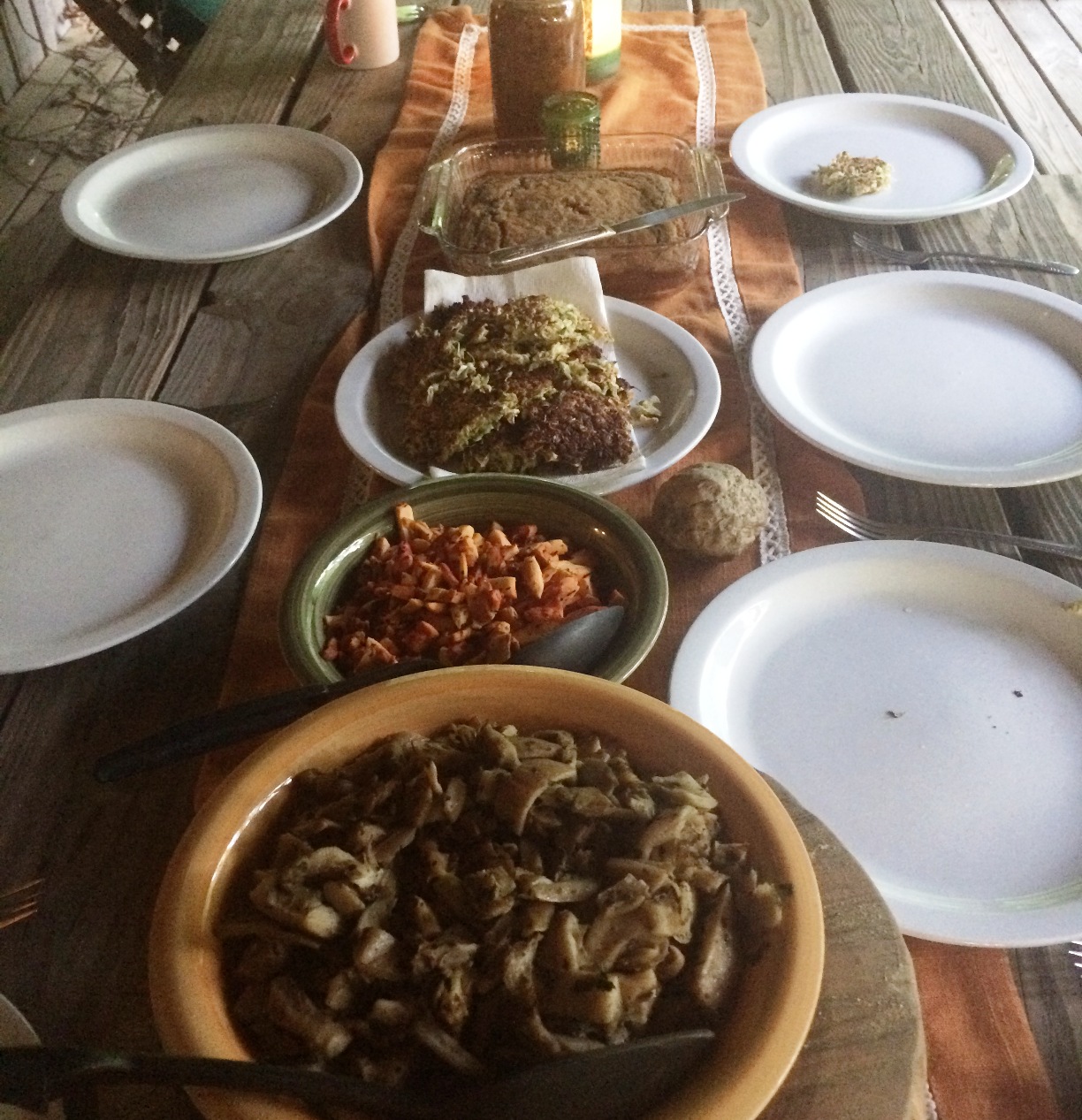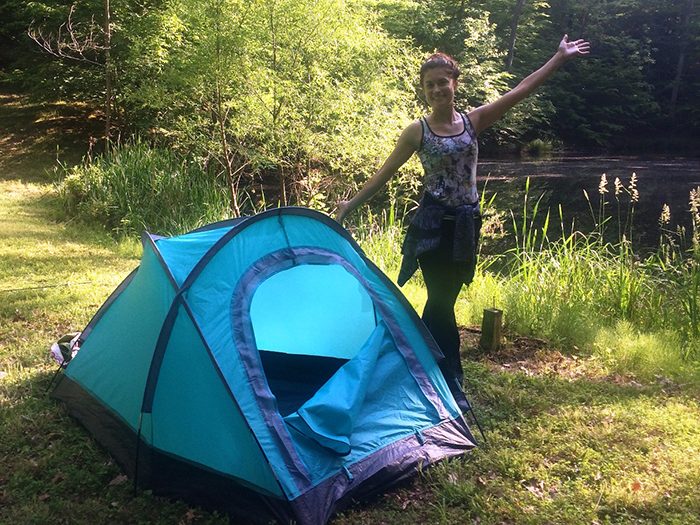When I found out about a weekend foraging excursion only an hour from where I lived, I signed up immediately and bought a tent.
My husband was dubious: I’d never put up a tent by myself and I did not have a great history with plants.
My knowledge was limited to the common herbs and plants one might see in a garden or grocery store, I’d had many failed attempts at growing my own food, and I’d even killed a cactus that I kept as a houseplant.
In other words, I was the Gomer Pyle of horticulture.
But I was hungry for the teachings of the quiet forest and I knew that to become good at something, I must be willing to be very bad at it initially.
When the time came, I departed with a small group of people from Wild Persimmon School, an herbalism school founded by forager, herbalist, and plant enthusiast Greg Monzel, who had a quiet, gentle presence that seemed otherworldly.
After driving through a few small, quaint towns that featured shops like “White Witch Botanicals,” we found ourselves deep in the forests of Nashville, Indiana.
The busy city life felt distant as the sounds of trains and car horns were replaced by the chorus of birds and the rustling of leaves as animals foraged for food, setting the example for our small class. After a couple of false starts, I breathed a deep sigh of relief and satisfaction as I put down the last stake of my tent on a strip of land near a large pond and fell asleep to the strange bovine melody of bullfrogs calling to one another across the water.
Pants tucked into our socks to keep ticks out, our motley crew headed into the forest the next morning for what I thought would be the easy part of the trip. After all, I’m a proud Ravenclaw who’d mastered the art of learning new things. I’d even managed to put up a tent by myself (mostly).
Little did I know, there are so many more plants than I ever knew existed in one small patch of forest within one dot on the global map. There are many species of plants and there can be quite a bit of variation with each species. For example, a young plant looks different from an older plant of the same species, just like people.
We learned to look at details that often go unnoticed, such as the shape of the leaf. Is it ovate (egg-like) or auricular (ear-like)? Does it have smooth or serrated edges? Do the leaves grow in a pinnate (feather-like) or palmate (hand-like) fashion? Are they furry? Smooth? What do they smell like if you rub them between your fingers? Lemony? Peppery? Minty? How big are the leaves and how many leaflets per leaf?
Oh yeah—you have to learn the difference between a leaf and a leaflet, which I’m still not sure I understand. A leaf can have many leaflets, which I thought were just individual leaves. And that’s only leaves, people, never mind the stem and root, and flower, berry, or nut it might yield.
By the end of the day, my head contained a confused swirl of images of the 30 or so plants we’d identified in half a day.
One day, we managed to find a large percent of that night’s dinner: wild lettuce, mint, and varieties of sorrel for salad; wild rose, violet, red clover, and wild mint for tea. Although I usually prefer black tea to herbal tea, this may have been the best cup of tea I’ve had—ever. We also found a huge cluster of orange-colored mushrooms called Chicken-of-the-Woods, aptly named for possessing the meaty look and texture of chicken, as well as a hearty supply of oyster mushrooms.

Another day, we collected stinging nettles in order to make a tincture, which could be used to relieve pain and alleviate the symptoms of allergies. When I learned about the immune-boosting properties of nettles, I happily allowed them to sting me in this tick-infested forest. Under a makeshift shelter in the pouring rain, we made the tincture right on the spot.
On our last day, as if following an intuitive scent, Greg led us off trail where we found goldenseal and ginseng. We stood in awe for a moment as we looked at these highly sought-after plants that bring in big dollars for foragers due to their healing powers and scarcity. We did not harvest these plants, which are now in danger due to being overharvested. It was magical finding these plants, though, and for our guide, it was almost like finding a unicorn asleep in the forest.
Few things are more satisfying than gathering one’s own food in the wild.
Foraging is not only a great way to learn about the natural world, but also to connect with our hunter-gatherer ancestors. Unplugging from the modern world to engage in an activity that resonated with my DNA was the elixir my nervous system so desperately needed.
For those inspired to venture into the world of foraging, here are some tips for the beginner (and reminders for those with more experience):
1. If you know nothing about plants, start with your backyard. Grow various herbs and vegetables so you can identify them easily. Become familiar with the “weeds” in your yard. Some of them have medicinal properties, such as stinging nettle, plantain, and dandelion.
2. Sign up for a foraging excursion with an expert. Take notes, draw pictures, and take photographs of the plants and then study them more in depth on your own. Be sure to study poisonous look-alikes, such as milkweed versus dogbane.
3. Never put something in your mouth without positively identifying it using a variety of reliable sources or until you’ve become so intimate with the plant that you can recognize it without a shadow of doubt. Some plants are so toxic that even putting them in your mouth and spitting them out can have serious consequences.
4. When identifying or studying a plant, pay attention to details beyond the leaves. If you look at a cross section of the stem, for example, is it triangular, square, or round? Does a milky substance come out when you cut it? What color is it?
5. For the ecological well-being of the forest, never harvest all or even the majority of plants from one location. Instead, harvest a few plants in various places throughout the forest, and don’t take more than you need.
6. Respect all plants, for they all have a purpose. Learn about their purpose in the forest’s ecosystem. For example, mushrooms will uptake heavy metals, thereby protecting the plants around it.
7. Study the medicinal qualities of plants in your area and learn to make tinctures from plants you harvest. Kept at cool temperatures, tinctures last for months, if not longer, and are valuable additions to one’s medicine cabinet.
~







Read 0 comments and reply